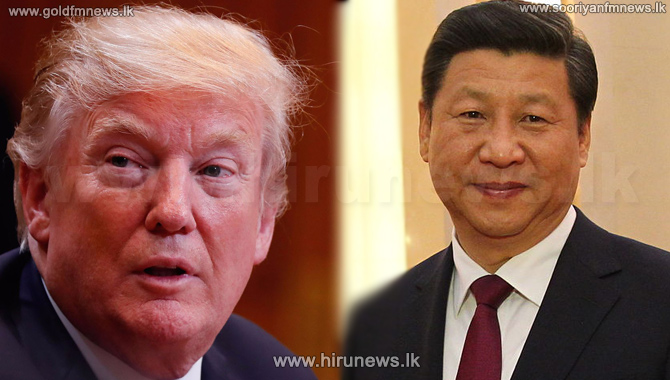-By Anubhawananda

(Lanka-e-News -15.May.2025, 11.30 PM) In an age where global influence increasingly hinges not on firepower but on factory output, the United States—once unchallenged in its economic hegemony—now finds itself staring down the barrel of a new kind of superpower. China, the ancient nation once dismissed as a lumbering paper tiger, has risen in a fashion both formidable and irreversible. And as the world watched, Donald Trump—America’s self-styled strongman—blinked first before the Chinese juggernaut.
Modern China was not born overnight, nor was its ascendancy accidental. Its founding architect, Deng Xiaoping, a survivor of Mao Zedong’s cultural purges, emerged in 1978 to steer China away from ideological fanaticism toward pragmatic reform. His legendary dictum—“To be rich is glorious”—didn’t just reshape Chinese economic policy, it rewrote the national psyche. Deng dismantled collectivism, introduced agricultural reform, and carved out five Special Economic Zones that would turn sleepy coastal towns into global export hubs. In doing so, he set free the ambitions of a billion citizens, lifting hundreds of millions out of poverty and paving the way for China’s transformation into the second-largest economy on Earth.
While modern China rarely parades the memory of Chairman Mao, it occasionally summons his defiant spirit in times of strategic necessity. One such moment occurred during Trump’s “reciprocal tariff” tantrum, when China’s Foreign Ministry pointedly posted an archival video of Mao vowing to resist the U.S. to the bitter end during the Korean War. The message was as subtle as a hammer on porcelain: if a trade war is what Washington wants, Beijing will not flinch. For those fluent in Chinese political theatre, this was not mere nostalgia—it was a calculated act of geopolitical signalling.
China's rise has been neither meteoric nor miraculous. It is the product of cold, deliberate planning: a long game played with short bursts of radical action. In 2000, China accounted for a mere 8% of global manufacturing. Today, it hovers near 30%, dominating industries from solar panels to semiconductors. It has quietly seized market share from the U.S., EU, and Japan—not through tariffs or tantrums, but by investing in infrastructure, training its workforce, and mastering new technologies. The result? China is now the world’s leading trading partner, displacing America from a pedestal it once considered permanent.
The West’s handwringing over China's economic supremacy is, at best, unproductive; at worst, dangerously delusional. Competing with Beijing requires more than rhetoric—it demands structural policy reform. To match China's pace, nations must double down on education, invest in next-generation infrastructure, and adopt forward-looking technology strategies. But for decades, America has failed to rise to this challenge. Bereft of a coherent industrial policy, Washington has defaulted to monetary tinkering and populist scapegoating.
With little to offer in terms of economic recalibration, Donald Trump reached for the bluntest of tools: tariffs. These are not economic instruments so much as political totems. Economists warn that protectionism does not foster long-term prosperity—it merely reshuffles pain. Yet Trump wielded tariffs not for reform but for revenge, pointing fingers at allies and rivals alike in a bid to distract from America’s industrial malaise.
In truth, the greatest threat to American jobs was not Chinese competition but domestic automation. The American automobile industry, once a haven for well-paid blue-collar workers, has seen robots replace entire assembly lines. This, not trade, hollowed out the middle class. But demagogues seldom let facts get in the way of fury. Trump and his ilk found it politically convenient to blame Beijing for Detroit’s decline, rather than Silicon Valley.
China’s strategic foresight is most evident in its technological ambitions. In 2014, it unveiled the “Made in China 2025” roadmap—a masterplan to dominate emerging sectors from biotech to robotics. By 2017, Beijing had declared Artificial Intelligence (AI) a national priority. While U.S. tech firms remained mired in quarterly capitalism, China backed its AI push with state capital and policy muscle. The result: China now leads the world in AI patents, applications, and research—having turned foresight into first-mover advantage.
Perhaps nowhere is Washington’s strategic myopia more glaring than in the electric vehicle (EV) race. Chinese firms like BYD have outpaced Tesla—not just in innovation, but in affordability. Yet instead of fostering competitiveness, Trump derided EVs as “leftist indulgences.” His administration rolled back green incentives, mocked climate science, and handed China the EV market on a silver platter. In a century where carbon consciousness defines industrial relevance, this is not just a policy error—it is geopolitical negligence.
Calls to decouple from China may provide catharsis for anxious pundits, but they ignore the brute reality of economic interdependence. American supply chains are inextricably linked to Chinese factories. American consumers are tethered to Chinese prices. And American innovation is now, paradoxically, dependent on Chinese production. Trump’s trade war, far from correcting this imbalance, merely showcased America’s dependency. Like a boxer swinging blindly in the ring, he hit only air.
The rise of China is not a passing storm; it is a structural realignment. The West must choose between two futures: compete wisely or retreat bitterly. The former demands policy courage, institutional reform, and long-term vision. The latter promises only nostalgia, decline, and the empty theatre of trade tantrums.
One might say Trump knelt before the dragon not out of deference, but because he ran out of moves. The world, meanwhile, keeps turning East.
-By Anubhawananda
---------------------------
by (2025-05-15 18:34:56)
Leave a Reply